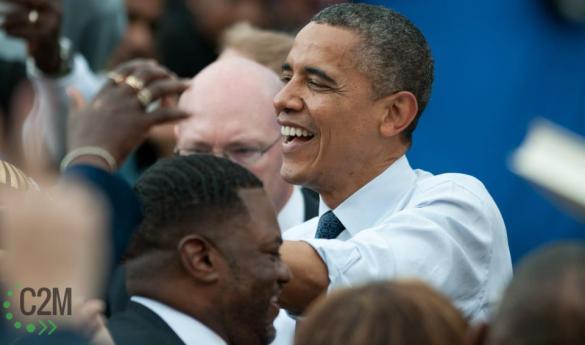NoVa plays critical role in Obama victory in Virginia
After numerous candidate visits to George Mason University and the surrounding area, Mason students and the nation voted to reelect President Obama to his second term in office.
Nationally, media outlets projected Obama as the winner around 11 p.m. after projecting that he won Ohio, a key swing state in the campaign.
Obama went on to win Wisconsin, Nevada, New Hampshire, Pennsylvania, Iowa, Wisconsin and Virginia, all of which were considered swing states throughout the election. Romney won North Carolina, another swing state focused on during the campaign.
As of 10:00 a.m. Nov. 8, Obama won 50 percent of the popular vote to Romney’s 48 percent. Obama has also received 303 electoral votes to Romney’s 206.
The winner of Florida, another contested swing state, is still unknown and the votes are in the process being counted. Obama has 49.9 percent of the vote, with about a 47,000-vote lead over Romney.
Obama took 50.57 percent of the vote in Virginia to Romney’s 47.85 percent.
In Virginia, Romney held an early lead from results in the southwest region of the state. The race began to tighten as results came in from areas in northern Virginia, such as Fairfax County, Loudon County and Prince William County.
In Fairfax County, Obama received 59.04 percent of the vote to Romney’s 39.51 percent, relatively unchanged from the 2008 results.
In the university precinct located on Mason’s Fairfax campus, 74.28 percent of students voted for Obama, while 22.15 percent voted for Romney. 1,598 total people voted at University Hall, a new polling location created in 2011.
Obama performed well in other college towns in Virginia, such as Harrisonburg, Charlottesville, Williamsburg and Fredericksburg, similar to his results in 2008.
Young voters had a large part to play in this year’s election. According to the Washington Post, voters aged 18-29 made up 18 percent of the total electorate in 2008, and Obama won them by 34 points. This year, voters aged 18-29 made up 19 percent of the electorate, and Obama had a 24-point lead over Romney.
Apart from the youth vote, Obama also received a substantial bump from women voters in the Virginia race. According to data accumulated by the New York Times, Obama received 54 percent of the women vote to Romney’s 45 percent. Nationally, Obama had an 11-point lead over Romney for the female vote.
In the Virginia senate race, Democrat Tim Kaine beat Republican George Allen for a seat being vacated by Democratic Senator Jim Webb.
Overall, Kaine received 52.27 percent of the vote to Allen’s 42.64 percent. Kaine received over 60 percent of the vote in Fairfax County and over 75 percent in the University precinct.
Nationally, Democrats retained control of the U.S. Senate with 53 seats, gaining a net of two seats. Republicans will have 45 seats, with a net loss of two.
Democrat Congressman Gerry Connolly was reelected to his third term in the House of Representatives, defeating Republican challenger Chris Perkins. In the 11th congressional district, Connolly received 60.37 percent of the vote to Perkin’s 35.92 percent.
In the University precinct, 69.60 percent of students voted for Connolly and 23.14 percent voted for Perkins.
In the House of Representatives, Democrats had a net gain of six seats with 192 total, and Republicans had a net loss of one seat, leaving them with a majority of 233 seats.
Read C2M's coverage of election day on our live blog. Also check out our stories from both the Obama rallies and the Romney rally.

